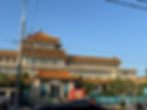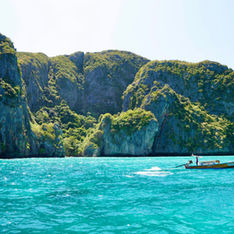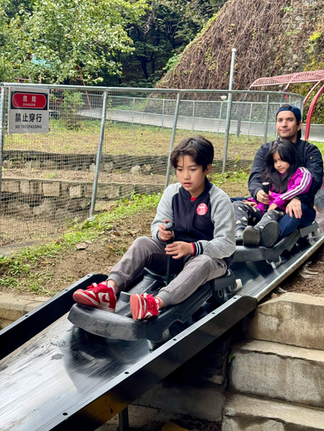🇨🇳 Beijing, China: Traveling with Kids. Family-friendly itinerary and Tips
- hummblylife
- Oct 20
- 9 min read

Many first-time travelers to mainland China (中國大陸, Zhōngguó Dàlù) start with the big cities — Beijing or Shanghai — and that makes perfect sense. These cities are well-prepared to welcome international visitors and are easier to navigate compared to smaller towns.

But the truth is, traveling to China in 2025 feels much easier than it used to be. Thanks to blogs, YouTubers, Facebook groups, AI tools, and countless other online resources, you no longer have to feel completely lost in a country where things work quite differently from what we’re used to!
There are countries where you can just improvise: buy your flights, book a place to stay, and figure out the rest when you arrive. China isn’t really one of those. It’s definitely a place where a little extra homework pays off.
Why?
Because:
They use different payment systems than we’re used to.
Museum and attraction bookings work in a unique way.
And until recently, tourist visas were still required for some of our family members (but not anymore! 🥳).
You can find more about these details in our other post about: Preparing for travel in China.

✨ Beijing with Kids: Intro
Beijing isn’t just China’s capital: it’s one of the most fascinating cities in the world to explore as a family. Home to over 21 million people, Beijing offers centuries of imperial history that can be felt in every corner, from its ancient hutongs (胡同 narrow alleyways that form the old city) to its perfectly maintained parks.

What struck us most about Beijing is its incredible cultural richness. The city is home to eight UNESCO World Heritage Sites, including the Forbidden City, the Great Wall, the Temple of Heaven, and the Summer Palace.

Beyond the landmarks, everyday life in Beijing is inspiring : elderly locals exercising in the parks at dawn, kids eating baozi (包子) or drinking suannai yogurt (酸奶), and groups of retirees dancing in public squares.
Simple, human scenes that make the city so alive.

Like all other capitals in the world, Beijing isn’t perfect. Traffic can still be tricky (especially when crossing streets with kids), and yes: honking is very common! 😅
Air quality has improved a lot in recent years, but smoking is still quite widespread.
Even for someone who speaks the language and feels close to the culture, small cultural shocks can still happen. That’s why we recommend preparing kids in advance: maybe talk about how “different” doesn’t mean “bad,” and how to respond with respect and curiosity when things surprise us.
When to Visit Beijing
Beijing has distinct seasons, and picking the right time of year can make a big difference — especially when traveling with kids.
🌸 Spring (April–June)
👍 Great time to visit. Temperatures range from 15–25°C, and the parks are full of blossoms. If you’re sensitive or have allergies, take precautions.
☀️ Summer (July–August)
Hot and humid, often reaching 35°C. It’s also peak season for local tourism, especially during school holidays.
🍂 Autumn (September–October)
👍 Considered by many the best season to visit Beijing. Mild temperatures, clearer air, and red-golden foliage everywhere. Tip: book early, as it coincides with Golden Week (first week of October). Some say it’s not a great time to go because of the crowds, but if you plan well, you can still enjoy the city a lot!
❄️ Winter (November–March)
Cold but magical. Temperatures can drop below –5°C. We’ve been in January, and it’s one of the coldest places we’ve ever experienced (and we lived in Scotland then!). If you don’t mind the chill, try ice skating at frozen lakes in parks or warm up with hot pot and fresh dumplings.

💡 Important Info Before Traveling to Beijing (and China)
💰 Currency: Chinese Yuan (CNY). Carry some cash and set up Alipay or WeChat Pay.
🔌 Power outlets: Types A, C, and I; 220V. Bring a universal adapter (some hotels provide USB ports).

📶 Internet: Google, WhatsApp, and Instagram don’t work without a VPN or eSIM — install before traveling.
📱 SIM/eSIM: Buy a travel eSIM (Nomad, Holafly, Airalo) or local SIM (China Mobile, Unicom) at the airport.
🩺 Health: Get travel insurance, private care can be expensive.
🚰 Water: Not drinkable, use bottled water.
🍜 Food tips: If you have allergies or dietary restrictions, prepare a note in Chinese (on your phone or printed). Bring a fork for kids in your bag if needed, some street stalls don’t offer them.
🚇 Transportation: Didi (China’s Uber) is affordable and convenient, but in some restricted zones (like the Forbidden City area) only the subway works.
✈️ Airports: Beijing Capital (PEK) and Daxing (PKX). Daxing is newer, but Capital is often more convenient, depending on your accommodation's location.
More detailed info for your China trip here.
Where to Stay in Beijing
We’ve stayed both in a traditional hutong residence and in a modern hotel near Dongzhimen, which is very well connected to the airport express and daily tours.
For families, Dongzhimen is one of the most convenient areas: easy Didi pick-ups, nearby subway, and many tour meeting points.
We stayed at the Holiday Inn Express Dongzhimen, booked through Booking.com — great value, good breakfast, laundry facilities, and friendly staff.
Right across the street, we found one of the best-rated Peking Duck restaurants, 京尊烤鸭店 (Jing Zun). Affordable, delicious, and literally one minute from our hotel: no waiting!
ℹ️ Important note: The area around the Forbidden City, including Tian’anmen Square, Wangfujing Street, and the National Museum, is restricted to taxis and Didi. That makes it less practical if you plan to use those frequently with kids.
Other hotels we considered:
CitiGo chain: CitiGo Sanlitun, CitiGo Sanyuanqiao, CitiGo Qianmen Street.
And Right Hotel.
Family-Friendly Itinerary: 1 Week in Beijing
(2 rainy days included — adjust based on weather and kids’ energy levels!)
Day 1: Arrival & Exploring the Neighborhood
We planned to take the Airport Express, but ended up using Didi — super easy! Follow the English signs at the airport to the Didi pick-up zone.
🚅 If you take the Airport Express from PEK:
Operates like a subway
Tickets at vending machines or counter
Fare: 25 RMB
Payment: cash, WeChat Pay, Alipay, or IC card (Yikatong)
To ask for help: 请问怎么买票?(Qǐngwèn zěnme mǎi piào? — “How do I buy a ticket?”)
After checking in, we just walked around, visited small shops, and watched daily life: schools, markets, and those tiny car-scooter hybrids that amazed the kids.


If you’re staying in Dongzhimen, you can go visit the nearby Ritan Park (日坛公园) or stop by a cozy bookstore café like Sisyphe Bookstore (Beijing Raffles City).
Too tired to go out? Order food through the Meituan app. We loved the robot delivery system! It takes the elevator, calls your room, opens its little compartment for your meal, then leaves, kids (and I 🤭) found it so cute! 🤖

Day 2: Historical Centers and Parks
Jingshan Park (景山公园) — The best panoramic view of the Forbidden City.
Climb to the top pagoda for stunning photos! Entrance is cheap (2 CNY p/p) and can be paid with cash or Alipay.


Then head to Beihai Park (北海公园) — boating, white pagoda, ducks, and peaceful gardens.
This became one of our favorite places in all of Beijing: clean, calm, and perfect for families.
Sometimes, it’s these quiet experiences, not the fancy theme parks, that create the most lasting memories. 🧡


We continued our walk towards the Art Museum area and visited the many cool libraries in the neighborhood!

We ended our day at Wangfujing Street (王府井大街). Walked +20,000 steps that day!

Our kids request: have a look at Hamleys, it cannot compare to the epic one in London, in fact the toy store with local brands across the street was much more fun with so many options.
Lots of restaurants in these area.
And another robot, this time, selling drinks:

Day 3: Art and Culture
China Film Museum (中国电影博物馆)
⏰ 9:00–17:00
Free entrance, reserve via WeChat (hotel staff can help).
Interesting for movie lovers, though not essential for families: lots of war-themed exhibits.

798 Art Zone (798艺术区)
⏰ 10:00–18:00
Modern galleries, outdoor sculptures, cafés, and creative shops in old factory buildings. Best on a sunny day! You can even rent small electric cars to explore.
Ditan Park, Lama Temple (雍和宮), Wudaoying Hutong, Drum Tower and Guijie (Ghost street)
The Lama Temple, built in 1694, was once Prince Yinzhen’s residence before he became Emperor Yongzheng.

Lama Temple At the Wudaoying Hutong, great place to grab something to eat, and so many coffee shops and cool independent shops. Walk all the way till the end and turn left to connect with the Jianchang Hutong (less commerce, more local feel) and you will soon reach the Drum Tower.

Smoothies in Wudaoying Hutong The Drum Tower dates back to the 13th century. once used to mark time each day for the entire city. Climb up for sweeping views of the surrounding hutongs.
Finish with dinner at Guijie (Ghost Street) — famous for its late-night food scene and lively atmosphere.
Día 4: Modern Beijing, Skyscrapers & City Life
A rainy day for us, so we went to China World Mall in the Guomao area, where the rooftop terrace has views of the CCTV Tower and CITIC Tower (China Zun) — Beijing’s tallest building.
Guomao Area / China World Mall's "China World Terrace" / CCTV Landmark (中央电视台总部大楼)
Great for a relaxed day indoors: luxury stores are not really our thing but we enjoyed the toy shops.
We had lunch at Jin Hu Hong Kong Style Restaurant (金湖港式茶餐廳) — delicious Cantonese food in the B1 floor.
If it’s sunny, visit Chaoyang Park (朝阳公园) and nearby Solana Mall, both great for families.
Or head to Sanlitun (三里屯) for a trendy, urban vibe with cafés and shopping.
Day 5: Forbidden City, National Museum and Tian'anmen Square
Important Info:
The Forbidden City now has one official entry (south, Meridian Gate 午门) and one exit (north, Gate of Divine Might 神武门). That means you walk south to north, so visit Tian’anmen Square and the National Museum first.
If traveling with toddlers or seniors, consider splitting them into two days, both the Forbidden city and the National Museum both require lots of walking.
But if you only have a few days in Beijing, we would recommend giving priority to the Forbidden City over the National Museum.
National Museum of China (中国国家博物馆)
⏰ 9:00–17:00 — Free, reserve via WeChat or their official website.
Perfect for understanding China’s long history and culture. And great option for rainy days.

You can also book through their official website (English version) and Trip.

Depending on how much your group can walk, you can easily spend around 2–3 hours in this museum.
When we came out, the rain had finally stopped (about time! 🥳), and the exit led us straight to Tian’anmen Square.
Tian’anmen Square (天安门广场) was built in 1651. As many know, it has been the site of significant historical and political events in China, but to be honest, from a child’s perspective, it’s simply a big square. The important thing is to give them some context that’s appropriate for their age.

Then, explore the Forbidden City (故宫博物院):⏰ 8:30–17:00 (closed Mondays)
🎟️ Reserve online: Trip.com or WeChat mini-programs


Top 3 Must-Sees:
Meridian Gate (午门) – the grand southern entrance.
Hall of Supreme Harmony (太和殿) – the majestic throne room used for ceremonies.
Imperial Garden (御花园) – a peaceful end to your visit with ancient cypress trees and stone paths.
Day 6: Imperial Gardens & Olympic Spirit
Morning: Summer Palace (颐和园 Yíhéyuán)

⏰ 6:30–18:00 (last entry 16:00)
Walk across the Seventeen-Arch Bridge, boat on Kunming Lake, and enjoy the peaceful hills and temples.
Take metro line 4 to Beigongmen.
Afternoon: Beijing Olympic Park (奥林匹克公园 Àolínpǐkè Gōngyuán)
⏰ 9:00–21:00
Home to the Bird’s Nest Stadium (鸟巢) and Water Cube (水立方).
The area lights up beautifully at night.
Dinner nearby at Olympic Center Mall, which also has indoor play areas for kids.
Día 7: La Gran Muralla de China
Gran Muralla (长城) – Mutianyu o Badaling
⏰ 7:30–17:30
KLOOK We joined a Klook tour to Mutianyu, which was perfect for families.
Take the cable car up and the toboggan down: super fun for kids!
Bring water and snacks, but travel light.
We’ve also visited Badaling section, but for families, Mutianyu felt more relaxed and less crowded.
After returning to Dongzhimen by 4 PM, we rested and packed for our early morning flight.
If you still have energy, you can visit the Temple of Heaven (天坛) before leaving.

Temple of Heaven (天坛 Tiāntán)
⏰ 6:00–21:00
Built in 1420 during the Ming Dynasty, it’s where emperors prayed for good harvests. Famous for its blue triple-roofed Hall of Prayer for Good Harvests, built entirely without nails. The surrounding park is vast and full of locals dancing, singing, and playing, a truly special spot.

🧡 We hope this guide helps you plan your own family trip to Beijing!
If you found it useful, share it with friends and follow us on Instagram for more real-family travel inspiration.










































































